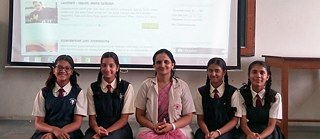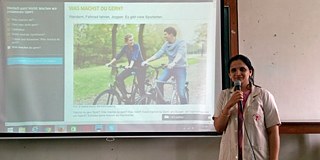German for you
Learning together in a worldwide community

The “Deutsch für dich” (i.e. German for you) community offers plenty of opportunities to make foreign language teaching fun. A competition for teachers revealed the best ways to incorporate the online platform into German as a foreign language lessons.
Deutsch für dich (i.e. German for you) is the Goethe-Institut’s free online community for learners and teachers of German around the world. Members of the community have access to online exercises and interactive learning games for all language levels, allowing them to practise and improve their German. They can get to know one another in forums relating to particular topics or in chatrooms, and help each other when they have questions about Germany or German. Learning partnerships can be arranged using “Deutsch für dich”, too. What the platform offers in terms of independent learning and exchange with others also provides teachers with many useful ideas for their German lessons.
Practise and repeat
Winning entries in the “Deutsch für dich” in German lessons competition for teachers illustrate how teachers can use Deutsch für dich in the classroom.The “Lernen” (i.e. Learning) section contains exercises and learning games that are relevant to the worlds in which the learners actually live, and which can be used to supplement existing lesson content. Whether it is a question of interactive grammar, coping with everyday life in Germany or the music videos of well-known bands, a search filter helps the user select suitable tasks for different language levels, topic areas, media formats (video, audio, text) and core skills (grammar, listening, reading, writing, vocabulary). With the aid of short, realistic video sequences, beginners can repeat the first steps in everyday communication, such as buying something in the bakery or talking about sports activities – as the lesson idea created by Yashashree Devdikar from Sinhgad City School in Pune/India (one of six third-placed entries) shows.

Accessing and exploring topics
Advanced learners can use exercises based on politics, society, culture or technology to familiarize themselves with typically German topics such as the Berlin Wall. Current phenomena and debates together with their respective vocabularies are also featured. For example, the lesson idea submitted by Zuzana Marková (Platz 1), a German as a foreign language teacher at the Goethe-Institut in Bratislava, uses exercises designed to accompany the Goethe-Insitut’s touring exhibition Umdenken – Von der Natur lernen (i.e. Rethinking – learning from nature). To introduce them to the complex issues addressed in the exhibition Fortschritt und Umweltschutz (i.e. Progress and Environmental Protection), pupils can use “Deutsch für dich” to engage with the four elements – fire, earth, water and air – before visiting the exhibition. They can develop their first thoughts and opinions and then further reflect upon and discuss them later with other German learners in the community.Making friends and sharing
In addition, “Deutsch für dich” offers its community members various ways of contacting one another – using the comments feature in the individual exercises, in forums, in groups they set up themselves or in the chatroom. They can ask questions here, take part in discussions, help others or practise writing to their learning partners. The topics that are raised reflect the things that matter to learners of German. For instance, groups may focus on the meaning of particular words, the city of Berlin, television series or what they did at the weekend.These possibilities for communication, as places for dialogue, networking and authentic language use, can be productively incorporated into German lessons.
The forum “Deutschland aktuell” (i.e. Germany today) for example is used by Natalia Sizova from Kostroma State Technological University in Russia (second place) as the starting point for her lesson idea. She uses the posts of other members as a means of encouraging her own pupils to read, write and share opinions about their own interests. Surveys or research can also be carried out in a forum or group. Thanks to the international users of this global platform, it is particularly easy to engage in intercultural exchange and make comparisons. Furthermore, they can pass on questions that have arisen in their lessons: points of dispute in controversial subjects, for instance, or indeed questions of comprehension that are difficult to resolve using other learning media. Amongst other things, the community was able to clarify the meaning of the word “Sozialschmarotzer” (i.e. benefits scrounger) and the use of the synonyms “Nachspeise” and “Dessert” (i.e. dessert).
Autonomy and authenticity as motivating factors
As an interactive online community, “Deutsch für dich” serves as a counterpoint to the kind of curriculum-based German lessons provided by schools, language schools and other language learning institutions. Learners can work autonomously at their own individual pace, either alone or with others, pursue their own interests and get in touch with one another in an informal manner. Roles can be reversed when learners become teachers by contributing their own knowledge to the community. They share thoughts and opinions, engage in genuine discussions and establish interpersonal relationships.This allows them to experience a different kind of learning, which can be used to make lessons more varied and therefore more appealing. What is more, using “Deutsch für dich” in the classroom motivates learners to continue taking advantage of the community themselves outside lesson time. The communication functions in particular allow the gap between textbook situations and authentic language use to be bridged.